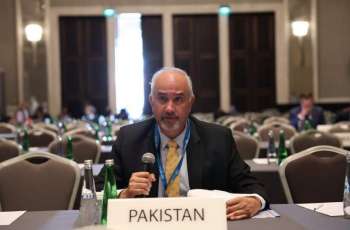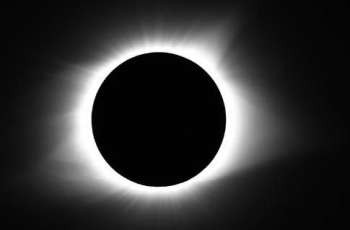PORTLAND (Pakistan Point News / Sputnik - 29th July, 2020) Portlanders say that the deployment of federal forces rekindled already waning protests in their city which has risen to dust off its rebellious legacy and remind the entire nation why it once came to be known as "Little Beirut."
Portland, a predominately white city in America's northwest, is home to the country's longest and arguably most intense riots, raging for over two months.
Like elsewhere in the United States, the campaign started in the wake of the police-involved death of African-American man George Floyd, and was losing steam - also like everywhere else - until President Donald Trump sent over a hundred heavily armed law-enforcement agents with a stated objective to protect a federal courthouse in the Democratic-run stronghold of the liberal opposition.
"It altered the whole thing. It made it more national, more politicized, you know, beyond just the Black Lives matter. Though BLM is still part of it, it has become more the anti-fascist, the anti-Donald Trump, the anti-federal police presence," Chris Ross says.
A bearded man in a helmet, a bullet-proof vest and a gas mask accompanies his 17-year-old daughter, Eddy Binford-Ross, who is the youngest reporter covering Portland protests - on an assignment for a high school newspaper.
According to Ross, by early July street activities in the city, where Blacks are just six percent of the population, would gather 50-100 participants and are suddenly back to thousands again as the federal presence made it more personal for a far wider range of Portlanders.
The city mayor Ted Wheeler accused Trump of "kicking the hornets' nest".
"We were coming to the end of our nightly demonstrations, at least the part where people were vandalizing things and some scattered acts of violence. We saw the energy coming out of that, we thought it would be done in a couple of days," Wheeler said in a recent CNN interview. "But then the federal government sent in dozens If not hundreds of troops. They engaged in what I would describe as a really abhorrent tactics. Basically, they blew the lid off this."
Portlanders, who see the deployment as an encroachment on their freedoms, each night rally in hundreds or thousands near a downtown courthouse protected by federal officers while a radical minority attacks the multistoried building.
Officers respond by tear-gassing, beating and shooting indiscriminately scores of people - peaceful and violent protesters, journalists, volunteer medics, human right activists, ever more fanning the flames.
BLM slogans in Portland are still embraced by protesters, who are predominantly white, reflecting the racial structure of the city and the state of Oregon. But almost everyone a Sputnik correspondent spoke to said that they are out in the street because of Trump's agents.
"Everybody has arrived in response to an ongoing presence. I am not happy about the return of violence, but happy that people are here, showing their resistance to the federal presence. I can't see where it ends up," a grey-haired biker Mathew Miller says. "There is a lot of BLM sentiment and chanting. It's an issue that people are aware of, but, yes, I am here because of the federal presence. It seems too much."
Dawn Swackhamer, a top manager in a major transnational corporation, says that a face-to-face encounter with police brutality was "infuriating" and only strengthened her resolve "to do something about that."
"They told us it was an unlawful assembly. But I don't agree with them. I was standing here holding my sign, chanting. There is nothing unlawful about that," she say.
Swackhamer is part of the "Wall of Moms" movement, dozens of women in yellow T-shirts who every night place themselves between federal agents and protesters, itching for a fight. "Wall of Moms" is often propped up by "Wall of Veterans," former servicemen, some handicapped, standing at attention with US flags turned upside down - a symbol of calamity, a nation in distress.
"We remember our oath, we remember who it was to - to the Constitution, therefore to the people, their right to a peaceful assembly, their right to speech, freedom of the press. All of these is being oppressed here. We will stand for it," Jonathan Depuis says. "I am going to stand in front of moms as long as I can and hopefully will make sure that any one who is speaking and needs to be heard is going to have this right and ability."
Josh Eagan, a young man in a fluorescent yellow-green coat, displays a large copy of the US Constitution with "Dead Document" hand-written right above "We, the People".
"I bought this at the Federal Archives in Washington, DC, when I was idealistic, when I believed in the Constitution. I took all the Constitutional courses, and I debated Constitutional law in the Washington State Capitol as a student," he explains. "The fact and the matter is that now I have a dead document in my possession and the only thing I can do now is go to the federal government and say 'This is not right.'"
Eagan sees a crackdown on Portland protests as more proof that the government will not hesitate to use force anywhere on anybody - "just like in Vietnam, just like in Iraq."
"Everybody has been affected. First it was the native peoples, the migrants, black communities. Now it's white cities of the northwest. Who is left?" he asks.
Eagan looks tense and distraught, sweating and blinking rapidly.
"Yes, I am afraid. The idea of getting gassed terrified me. This is my first time knowing that I am probably going to," he says.
Eagan had nothing to protect himself with except for a simple cloth mask.
A gas attack was especially brutal that night. Federals started scattering canisters in front of the courthouse seemingly before a peaceful prelude to riots was over and the radicals launched their routine assault against a metal fence surrounding the building. People lost their orientation in thick suffocating clouds, vomited, sneezed and coughed, cried for help, staggered along the walls half-blinded.
"They are not supposed to be militarized and sent to cities like that. They have no business being here. And they are violent. They are not behaving in a way that our police should," says Emily Farrer, an IT executive and another "wall mom".
"Honestly, I think because we are a small city and mainly a Democratic, liberal city. To someone it may seem an easy prey to make a point," she adds.
A poor choice, perhaps. Portland has a lengthy record of defiance. The Oregonian, the oldest West Coast periodical, has compiled a list of 21 mutinies starting with a labor dispute of 1934 when Portland longshoremen tossed guards into the water in a protest against efforts to bring in replacement strikebreaker workers.
The writer Chuck Palahniuk described in his book how in the late 1980s President Ronald Reagan and his Vice President George H.W. Bush dreaded coming to the city where they were always met with protests. They dubbed the city "Little Beirut" after the Lebanese capital, engulfed by civil war and urban fighting at that time.
Local anarchists would gather in front of the hotel, eat potatoes dyed with food coloring and "then, when the motorcade arrived, drank Syrup of Ipecac and puked big Red, White and Blue barf puddles."
"Okay, okay, what nobody knew is stomach acid makes blue food coloring turn green. So it looked like a protest against Italy... It's the thought that counts," Palahniuk wrote.
Aesthetics is still a big part of Portland protests, where a naked woman displays her fit body in front of advancing policemen, a lama is brought to the courthouse square, a volunteer medic dons medieval armor, teenagers try to imitate combat formations of commando teams, a band plays the Darth Vader march when the federals step out of the building.
There is also an African American wearing a bullet-proof vest with gold-plated buckles and a Russian-language sign НЕ СТРЕЛЯ� - "Don't Shoot" - on the back.
Protesters are innovative and love team work. They enthusiastically set up walls of umbrellas and homemade shields against tear gas and various projectiles, chase smoking canisters to cover them with plastic road cones and throw them back with lacrosse and hockey sticks. Leaf blowers are used to dissipate chemicals, soap bubble machines - to show the wind direction.
On the offensive side they pelt the courthouse and the federals if they are outside with firecrackers. They set up blazes and attempt - often successfully - to tear down the fence.
"Big change never comes through passive protests. I think the sacrifice of some graffiti and buildings is worth the change that these people here are driving for," Swackhamer says.
Another Portlander who did not identify herself disagrees: "It has gone too far, they have lost the message."
Protesters do not even try to go hand-to-hand with the federal agents or to resist their charge.
"There are no leaders... people are looking for someone to follow. We are a whole bunch of followers, waiting for a leader. That's a sad thing to say," Dailon, a Black volunteer cook at an improvised Riot Ribs cafe, says. "Until they find a voice, somebody like a speaker who can actually speak for them, they will just tear shit off. That's not BLM now, it has gone away, it's nasty, ugly."
Violent as they are, protests remain focused on the courthouse and a small adjacent area with the rest of the city continuing with its daily routine.
A Sputnik reporter, who worked in Portland for almost a week, has not seen any significant acts of looting or vandalism not directed to the single federal building. In contrast to other hotspots, like Minneapolis or Washington at the height of disturbances there, many windows in the downtown area are uncovered with plywood panels but still survive nightly riots.
In Portland journalists are more likely to hear words of appreciation "for being with us," unlike in Seattle and again Washington where attacks by ideological opponents and emotionally unstable individuals were commonplace, and crowds sometimes aggressively resist being filmed out of fear that video and photo records may be used by the police.
"City of the politest protests in the country. Sounds like a new tourist slogan," a hotel manager laughs after hearing the observations in a late night small talk with a visiting reporter.
Night-time protests seem to be a popular social activity and entertainment in the city which is still much under coronavirus lockdown with restaurants mandated to stop serving food by 8.00 and drinks by 10.00 p.m. In the daytime riots subside and government contractors are free to clear garbage around the courthouse and repair the fence ahead of another night.
"I think it's horrible. This is our city they are destroying it. No matter what they say, this is our city. Businesses are hurting and everybody is hurting. Hopefully they don't get into the building. It will be a bad mistake," the head of a contracting company says. "There is over a hundred people in there, they are watching us right now as I am talking to you. They don't come out, they stay in there. They are watching us on their cameras, the whole perimeter is under surveillance."
According to media reports, the Department of Homeland Security originally chose for the Portland mission around a hundred fighters from BORTAC, a commando-type unit of the US Customs and Border Protection, created to serve "a civil disturbance function in response to rioting."
The Washington Post said the Trump administration recently doubled the contingent and is considering sending 50 more.



